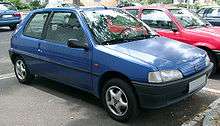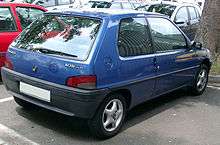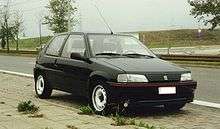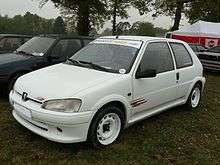Peugeot 106
| Peugeot 106 | |
|---|---|
_01.jpg) | |
| Overview | |
| Manufacturer | Peugeot |
| Production | 1991–2003 (2,798,200 units) |
| Assembly |
|
| Body and chassis | |
| Class | Supermini (B) |
| Body style |
3-door hatchback 5-door hatchback |
| Layout | Front-engine, front-wheel-drive |
| Related | Citroën Saxo |
| Powertrain | |
| Engine |
1.0 L I4 (petrol) 1.1 L I4 (petrol) 1.3 L I4 (petrol) 1.4 L I4 (petrol) 1.6 L I4 (petrol) 1.5 L I4 (diesel) 11 kW/15 hp (electric) |
| Dimensions | |
| Wheelbase |
2,385 mm (93.9 in) (1991–96) 2,387 mm (94.0 in) (1996–2003) |
| Length |
3,564 mm (140.3 in) (1991–96) 3,678 mm (144.8 in) (1996–2003) |
| Width |
1,590 mm (62.6 in) (1991–96) 1,594 mm (62.8 in) (1996–2003) 1,610 mm (63.4 in) (GTi) |
| Height |
1,369 mm (53.9 in) (1991–96) 1,380 mm (54.3 in) (1996–2003) 1,357 mm (53.4 in) (GTi) |
| Curb weight | 790–950 kg (1,741.7–2,094.4 lb) |
| Chronology | |
| Predecessor |
Peugeot 205 Peugeot 104 |
| Successor |
Peugeot 107 Peugeot 206 |
The Peugeot 106 is a supermini produced by French automaker Peugeot between 1991 and 2003.
Launched in September 1991, it was Peugeot's entry-level offering throughout its production life, and was initially sold only as a three-door hatchback, with a five-door hatchback joining the range early in 1992. For the first year of production, the 1.0 and 1.1 petrol engines came with a carburettor, but were replaced by fuel-injected engines from late 1992 as a result of EEC emissions regulations.
Phase I


The Peugeot 106 was introduced on 12 September 1991[1] as the French marque's entry level car slotting in beneath the 205, some two years after Peugeot had first released images of a new smaller supermini. It was a substantial development of the Citroën AX platform and was aimed directly at the Renault Clio, which had gone into production a year earlier, and as a more modern alternative to the slightly larger 205 which had been a massive success for Peugeot and was still proving hugely popular almost a decade after its launch. Like the AX and the 205, the car had all independent suspension with MacPherson struts at the front, and compact transverse torsion bars at the rear. Sales in the United Kingdom began in November 1991, initially only with a three-door model, although the five-door version was added in early 1992.
Trim levels were basic XN, mid-range XR, top-spec XT, and the sporty XSi model (capable of 120 mph) mentioned above.
In addition, from 1994 onwards there was a "Rallye" model offered. This was different from the XSi model with the TU2 series 1.3 litre petrol injection engine (100 PS (74 kW)), and was only available in red, white or black. This stripped out version was designed for the sporting driver, and had little in the way of creature comforts, such as electric windows or power assisted steering. On the phase 1 model, a sunroof and anti lock brakes were the only options available from the factory, although many came with foglights or spoilers from the XSi models. In Portugal there was a special edition of 50 units of the Rallye, called R2, which feature extensive use of sporting material from the Peugeot-Talbot racing division which went even further with the extreme nature of the Rallye, with changes to the suspension, brakes, new 14 inch Speedline Mistral rims, racing seatbelts, and engine management and Devil exhaust upgrades, to produce 106 PS (78 kW).
Phase II
_02.jpg)
In January 1996, the Peugeot 106 also formed the basis for the near identical looks and size Citroën Saxo, and at this time the 106 received a facelift which saw all engines get fuel injection and equipment levels raised. Carburetors were replaced by fuel injection as a result of EC regulations. The XSi was dropped in favour of the new GTi model with a 1.6 16v engine.
From 1996 the trim levels were XN, XL, XR, XT, XS and GTi. In October 1998, the Peugeot 106 range was reduced to the 1.1 L petrol (Independence, XN, XL, XT Look or Zest 1/2/3), 1.4 petrol (XR, Roland Garros or Quiksilver), 1.6 8v petrol (XS or Rallye) and 1.5 L diesel (XND) models as well as the 1.6 16v petrol (GTi/S16). This was due to the launch of the larger 206, which stole many sales from the 106. Peugeot initially intended to phase the 106 out, and market the 206 as its replacement, but later decided to keep building the 106 until it could be replaced with another all-new model.
In January 2004, the last Peugeot 106 rolled off the production line. Its replacement, the 107, has been available since January 2005. By the time production ceased, the Peugeot 106 was one of the longest running production cars still made in Europe, but it was still selling fairly well, especially in its home market of France.
Rallye version

Marketed as having "fewer frills, more thrills", the Rallye version did not have alloy wheels, central locking or electrically operated windows to keep the weight down to 825 kilograms, powered by a 1.3-litre petrol engine developing 100 bhp at 7200 rpm. It had a five-speed manual gearbox. From 1997 to 1998, the Phase 2 Rallye was offered, and these combined the light, nimble chassis of the Phase 1 Rallye, with a 1.6-litre petrol injection engine (TU5J2, 103 PS (76 kW)) and updated looks and safety features of the later models (1996–1999). Optional Extras on the Phase 2 Rallye were; Power assisted steering, airbag and a sunroof. Note that in some European markets (e.g. Greece) the phase 2 Rallye adopted the GTi's 1.6L 16v engine performing 120 hp from 1998 onwards. That (plus the racing success in group N category of hillclimbing rally in Greece) boosted its sales and made the car the hottest small hatch at the time.

The vehicle could be competitive in racing, but also made a practical family car.[2] The Rallye also got a facelift in 1996, sporting a larger 1.6-litre petrol engine developing 103 hp at 6200rpm.
Equipment
The 106 featured all round independent suspension with MacPherson struts at the front, and compact transverse torsion bars at the rear. Low-end models have areas of visible metal work on the doors and a generally more sparse interior. 1.0L and some early 1.1L cars were fitted with a four-speed manual gearbox, with all other models having a five-speed manual with an automatic gearbox as an option. Most models had only basic features, with even a radio being only an option on some variants, such as the 106 'Kid' special edition (which had denim effect fabrics). Many of the cars sold in the United Kingdom were special editions, carrying such names as Graduate, Inca, Aztec and Independence. These were often based on the XN trim vehicles, but with the addition of bodywork graphics carrying the name of the special edition, and a few other basic options such as a tilt and slide sunroof.
Higher up the range electric windows, central locking (standard on the Quicksilver/XR models), a manual pop-up sunroof (electric sunroof was a very rare extra), radio-cassette or radio-CD and rear wash-wipe were available. A driver's airbag was introduced in the Phase II model as an optional extra, although it came standard on late GTis. Early GTis featured optional black leather upholstery (later made standard), 14" Raptor alloy wheels, a body kit and disc brakes all round. The leather was much of the reason for the increase in price over the otherwise near-identical Citroën Saxo VTS. GTis built after 2000 are fitted with side airbags in the leather seats for added safety.
No Phase I cars had power steering in right-hand drive markets such as the United Kingdom, as there was no space for the power steering pump in these cars. This was rectified in Phase II cars, where power steering was available as standard in higher specification models, or as an option on lower specification models.
As with the Saxo, air-conditioning was never an option on right-hand drive 106s, because the blower motor was mounted in the bulkhead on the driver's side. As a result, there was insufficient space available to accommodate the evaporator, except by first ducting the air flow to the passenger side and then at the expense of the glovebox. Although an after-market kit was available that did exactly this, the resultant pressure loss made the system noisy and ineffective. The blower motor could also not be easily relocated, since the windscreen wiper motor was mounted in the passenger side space.
Electric version
In 1995, Peugeot launched an electric powered version of the 106, called the 106 Electrique. This was offered in a number of European countries including France, Belgium, The Netherlands, Norway and the United Kingdom.
The electric powertrain was developed and built by French engineering company Heuliez. The car used Nickel-cadmium battery technology manufactured by Saft Groupe S.A., had a top speed of 56 mph (90 km/h) and had an official range of 100 km (62 mi).
Despite the high price of the vehicle, Peugeot anticipated demand for around 15,000–20,000 Peugeot 106 Électriques each year, with an expected total production run of 100,000 vehicles. In the end, only 6400 Peugeot 106 Électriques were sold between 1995 and 2003, most purchased by the French Administration.
Petrol Engines
| Displacement | Type | Year | Fuel supply | Output | Models | Comments |
| 1.0 | TU9K | 1991–1992 | Solex Carburettor | 45 hp at 6,000rpm | Open, XN, Kid, Itinéa | This engine is fitted in most of the cars sold in Brazil, because of a tax on engines over 1.0 litres. |
| 1.0 | TU9ML/Z (CDY) | 1993–1998 | Mono–Motronic MA3.0 | 45 hp at 6,000 rpm | ||
| 1.0 | TU9ML/Z (CDZ) | 1993–1996 | Mono–Motronic MA3.0 | 50 hp at 6,000 rpm | ||
| 1.1 | TU1K | 1991–1992 | Solex Carburettor | 60 hp | Zen, Color Line, Quiksilver, Open, Equinoxe, Pop Art, Mistral, Kid, XN, XR, sketch | |
| 1.1 | TU1ML/Z (HDZ) | 1991–1997 | Mono–Jetronic | 50 hp at 5,800 rpm | ||
| 1.1 | TU1ML/Z (HDZ) | 1993–1996 | Magneti Marelli FDG6 | 60 hp at 6,200 rpm | ||
| 1.1 | TU1M (HDY) | 1997–1999 | Motronic MA3.1 | 54 hp at 6,200 rpm | ||
| 1.1 | TU1M (HDZ) | 1997–2001 | Motronic MA3.1 | 60 hp at 6,200 rpm | ||
| 1.1 | TU1JP (HFX) | 2000–2003 | Motronic MP 7.4.4 | 60 hp at 5,500 rpm | ||
| 1.3 | TU2J2L/Z (MFZ) | 1993–1996 | Magneti Marelli 8P | 98 hp at 7,200 rpm | Rallye » phase 1 | |
| 1.4 | TU3K | 1991–1992 | Solex carburettor | 75 hp | ||
| 1.4 | TU3M/Z (KDY) | 1991–1993 | Mono–Jetronic | 73 hp at 5,800 rpm | Color Line, Sport, Quiksilver, Enfant terrible, Equinoxe, Symbio, XR, XS, XT | |
| 1.4 | TU3FJ2 (KFZ) | 1991–1996 | Motronic MP3.1 | 95 hp at 6,600 rpm | XSi 1.4 | |
| 1.4 | TU3M (KDX) | 1993–1996 | Mono - Motronic MA3.0 | 75 hp at 5,800 rpm | ||
| 1.4 | TU3JP (KFX) | 1997–2001 | Magneti Marelli 1AP | 75 hp at 5,500 rpm | ||
| 1.4 | TU3JP/IFI4 (KFX) | 1998–2001 | Motronic MP7.3 | 75 hp at 5,500 rpm | ||
| 1.6 | TU5J2 (NFY) | 1994–1996 | Magneti Marelli 8P | 103 hp at 6,200 rpm | XSi 1.6 | |
| 1.6 | TU5JP (NFZ) | 1997–2001 | Motronic MP5.2 | 88 hp at 5,600 rpm | ||
| 1.6 | TU5J2 (NFW) | 1997–2000 | Magneti Marelli 8P | 103 hp at 6,200 rpm | Rallye » Phase 2 | |
| 1.6 | TU5J4 (NFX) | 1996–2003 | Magneti Marelli 1AP | 118 hp at 6,600 rpm | GTi, Rallye Phase 2 16V | In later years, Peugeot started putting the TU5J4 engine into the Phase 2 rallyes, though these were not available in every country. |
Diesel Engines
| Displacement | Type | Year | Fuel supply | Output | Models | Comments |
| 1.4 | TUD3Y (K9Y) | 1991–1994 | 51 hp at 5,000 rpm | XND, XRD, XTD | ||
| 1.5 | (VJX/VJU) | 1999–2003 | Bosch VP 20 | 58 hp at 5,000 rpm | In the United Kingdom, VJX engine code has Catalytic Converter, EGR and the fuel pump advance mechanism controlled by an ECU mounted on top of the battery. | |
| 1.5 | TUD5Y (VJZ) | 1995–2003 | Lucas Type 070 | 58 hp at 5,000 rpm | XRD, XND, XTD, Kid, Equinoxe, Open, Symbio, Color Line |
References
- ↑ "Peugeot offers new small car in Europe". Toledo Blade. Retrieved 2011-11-28.
- ↑ "Motoring / Road Test: Opening up a small package: Phil Llewellin enjoys the down-to-earth pleasures of the swift new Peugeot 106 Rallye, a delightful car that doesn't deserve its stripes". Retrieved 2015-06-28.
External links
![]() Media related to Peugeot 106 at Wikimedia Commons
Media related to Peugeot 106 at Wikimedia Commons
| « previous — Peugeot, a marque of Groupe PSA since 1976, car and LCV timeline, 1980s–present | |||||||||||||||||||||||||||||||||||||
|---|---|---|---|---|---|---|---|---|---|---|---|---|---|---|---|---|---|---|---|---|---|---|---|---|---|---|---|---|---|---|---|---|---|---|---|---|---|
| Type | 1980s | 1990s | 2000s | 2010s | |||||||||||||||||||||||||||||||||
| 0 | 1 | 2 | 3 | 4 | 5 | 6 | 7 | 8 | 9 | 0 | 1 | 2 | 3 | 4 | 5 | 6 | 7 | 8 | 9 | 0 | 1 | 2 | 3 | 4 | 5 | 6 | 7 | 8 | 9 | 0 | 1 | 2 | 3 | 4 | 5 | 6 | |
| City car | iOn | ||||||||||||||||||||||||||||||||||||
| 107 | 108 | ||||||||||||||||||||||||||||||||||||
| Supermini | 104 | 106 | 207 | 208 | |||||||||||||||||||||||||||||||||
| 205 | 206 | 206+ | |||||||||||||||||||||||||||||||||||
| Small family car | 305 | 301 | |||||||||||||||||||||||||||||||||||
| 309 | 306 | 308 | 308 | ||||||||||||||||||||||||||||||||||
| 307 | 408 | ||||||||||||||||||||||||||||||||||||
| Large family car | 504 | 405 | 406 | 407 | 508 | ||||||||||||||||||||||||||||||||
| 505 | |||||||||||||||||||||||||||||||||||||
| Executive car | 604 | 605 | 607 | ||||||||||||||||||||||||||||||||||
| Coupé | 406 Coupé | 407 Coupé | |||||||||||||||||||||||||||||||||||
| RCZ | |||||||||||||||||||||||||||||||||||||
| Convertible | 205 Cabriolet | 206 CC | 207 CC | ||||||||||||||||||||||||||||||||||
| 306 Cabriolet | 307 CC | 308 CC | |||||||||||||||||||||||||||||||||||
| Mini MPV | 1007 | ||||||||||||||||||||||||||||||||||||
| Compact MPV | 5008 | ||||||||||||||||||||||||||||||||||||
| Large MPV | 806 | 807 | |||||||||||||||||||||||||||||||||||
| Crossover | 2008 | ||||||||||||||||||||||||||||||||||||
| 3008 | |||||||||||||||||||||||||||||||||||||
| SUV | 4007 | 4008 | |||||||||||||||||||||||||||||||||||
| LAV | Bipper | ||||||||||||||||||||||||||||||||||||
| Partner | Partner | ||||||||||||||||||||||||||||||||||||
| LCV | J5 | Expert | Expert | Traveller | |||||||||||||||||||||||||||||||||
| J7 | J9 | Boxer | Boxer | ||||||||||||||||||||||||||||||||||